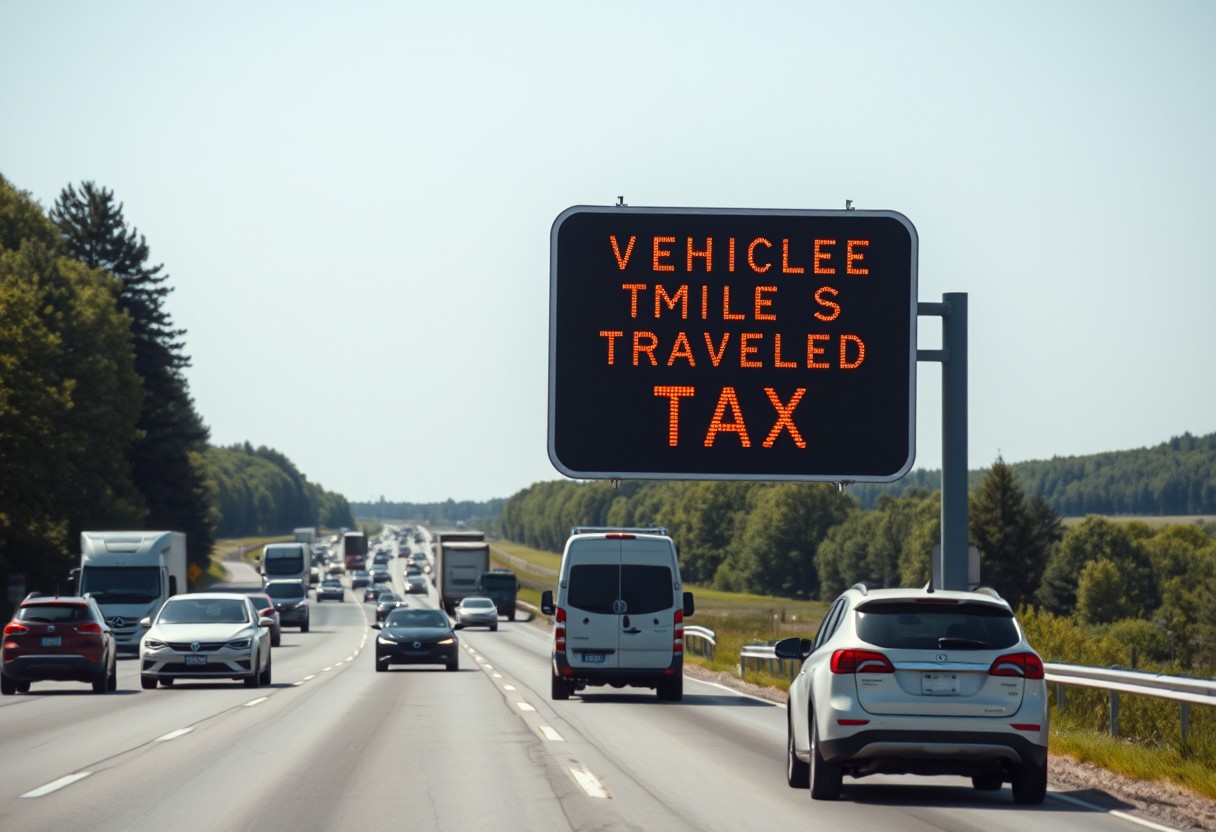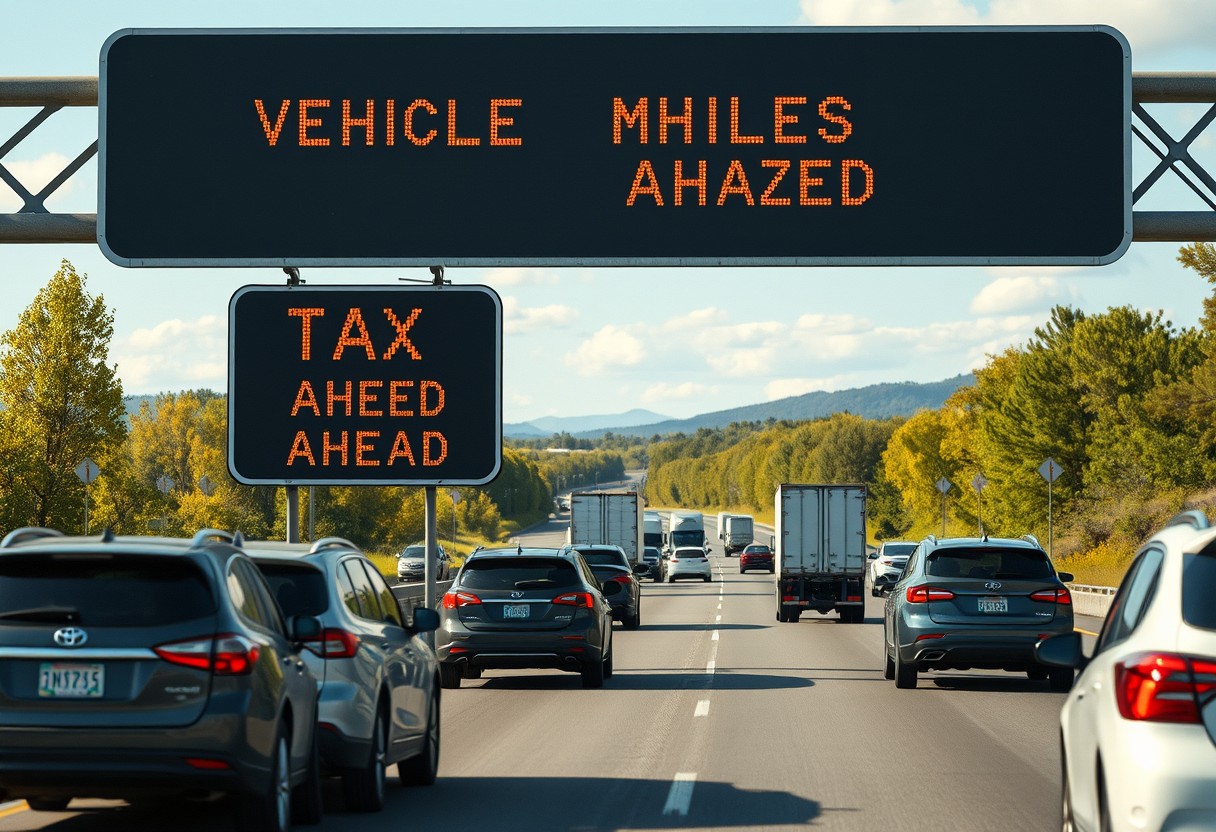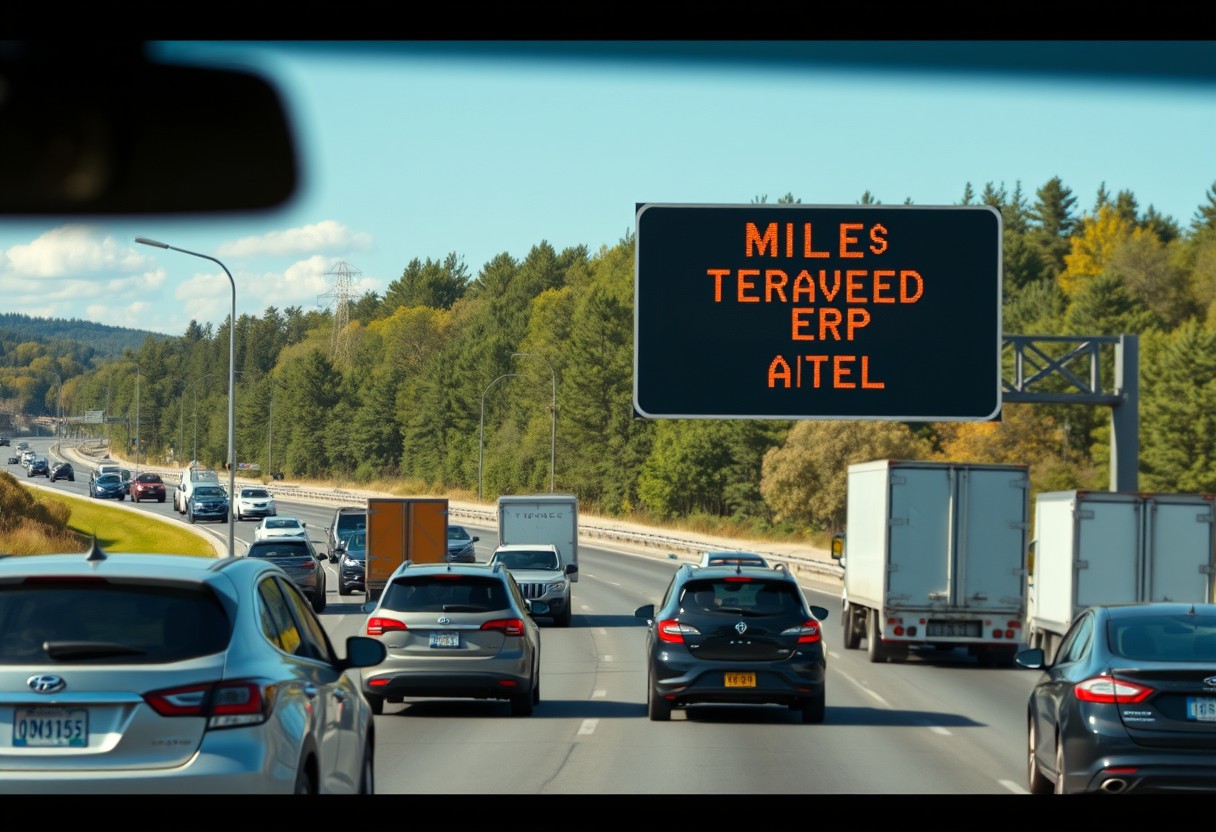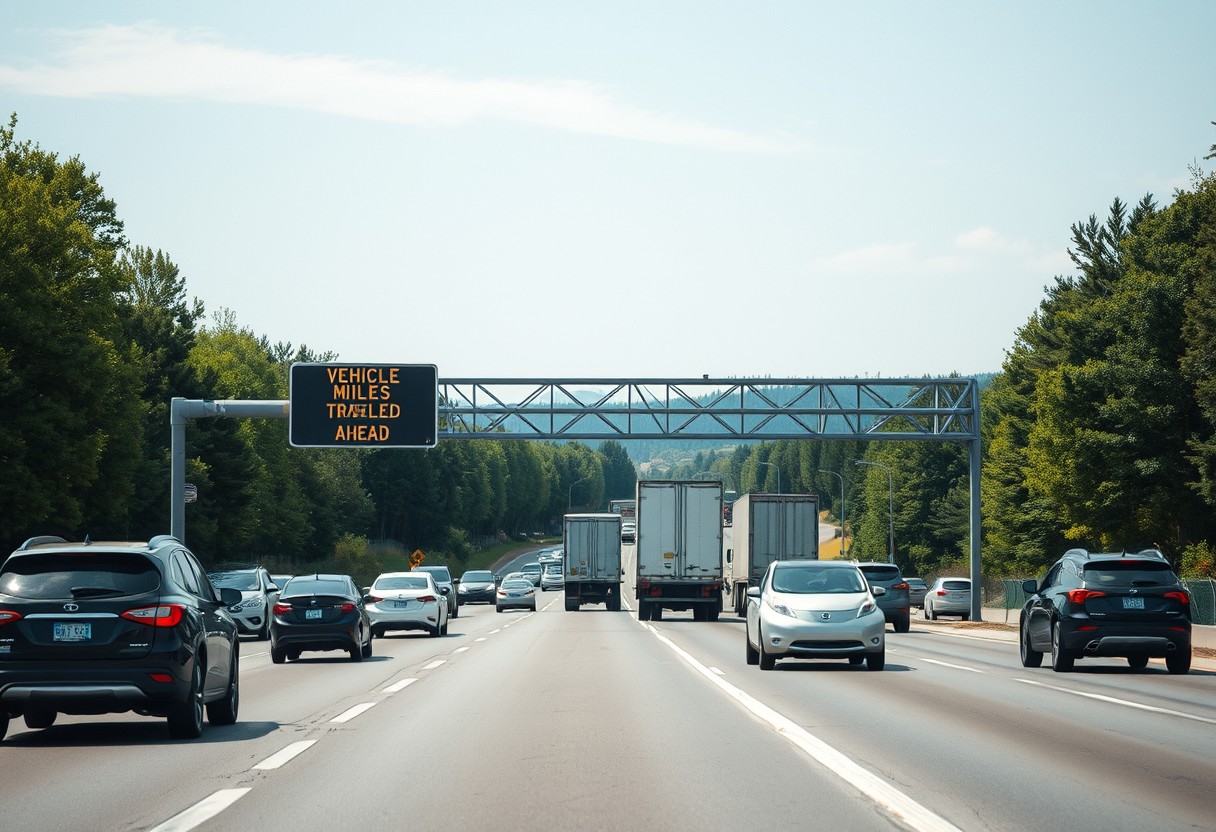Over the past few years, several states have begun implementing Vehicle Miles Traveled (VMT) taxes as a means to address funding challenges in the transportation sector. He, she, and they are witnessing a shift from traditional fuel taxes to this innovative model, which aims to charge drivers based on the number of miles they drive rather than the amount of gasoline they purchase. As states navigate the complexities of VMT systems, this blog post will explore the reasons behind this transition, the varying approaches taken by different states, and potential implications for drivers in the coming years.
Key Takeaways:
- Adoption Rates: Several states are actively piloting or implementing Vehicle Miles Traveled (VMT) taxes as a new revenue stream for transportation funding.
- Funding Alternatives: VMT taxes serve as an alternative to traditional fuel taxes, particularly in light of increasing fuel efficiency and the rise of electric vehicles.
- Technology Integration: States are utilizing advanced technology, including GPS and mobile apps, to track and report vehicle miles for accurate tax assessment.
- Privacy Concerns: Implementation of VMT taxes raises significant privacy issues related to data collection and monitoring of individual driving habits.
- Equity Considerations: Discussions around VMT taxes include the impact on low-income drivers, necessitating measures to ensure fairness in taxation.
- Implementation Challenges: States face various logistical hurdles in setting up the tax systems, including establishing public support and regulatory frameworks.
- Long-term Vision: Policymakers are envisioning VMT taxes as part of a broader strategy for sustainable transportation funding to meet future infrastructure needs.
The Need for Vehicle Miles Traveled Taxes
For many states grappling with budgetary constraints and aging infrastructure, the rollout of Vehicle Miles Traveled (VMT) taxes is becoming an crucial avenue for generating revenue. It offers a modern approach to address transportation funding issues that traditional fuel taxes are no longer able to effectively manage. As the nation evolves towards more fuel-efficient and electric vehicles, the reliance on gas taxes diminishes; therefore, states are seeking alternatives like VMT taxes to ensure sustainable financing for road maintenance and improvements.
Economic Necessity
Among the primary motivations for implementing Vehicle Miles Traveled taxes is the insistence on economic necessity. States face mounting pressure from both rising costs of infrastructure maintenance and stagnant revenue from traditional sources. By adopting a VMT tax system, they can establish a more direct correlation between road usage and funding, ensuring that those who use the roads more contribute proportionally to their upkeep.
In addition to addressing immediate funding concerns, the implementation of VMT taxes could promote local economic growth. Funds garnered from this tax could be reinvested into public transportation and infrastructure projects, which can, in turn, stimulate job creation and elevate regional economies. (Many states are already considering proposals to diversify their transportation funding mechanisms, which may include VMT taxes.)
Environmental Considerations
Any discussion of Vehicle Miles Traveled taxes cannot ignore the environmental implications. This tax structure encourages individuals to consider their driving habits and, consequently, reduces the overall vehicle miles driven. When people are mindful of their travel, they may gravitate towards more sustainable modes of transportation, such as carpooling, biking, or utilizing public transit. (Several states have enacted pilot programs that incorporate environmental benchmarks tied to VMT taxes.)
Additionally, VMT taxes serve as a mechanism to hold individuals accountable for their carbon footprint. By incentivizing reductions in vehicle usage, these taxes can ultimately lead to decreased emissions and contribute to improved air quality. (The environmental stakes are pushing lawmakers to increase their focus on promoting greener transportation options alongside VMT initiatives.)
Infrastructure Funding Challenges
It is evident that infrastructure funding challenges are a significant driver in the push towards Vehicle Miles Traveled taxes. As traditional funding sources come under pressure, the need for a reliable and sustainable method of revenue generation becomes paramount. Many states are finding that a VMT tax system could provide a more stable funding avenue compared to fluctuating gas tax revenues, which are affected by various factors, including market prices and consumer habits. (Recognizing this, some state legislators are advocating for pilot programs to test the effectiveness and practicality of VMT taxes.)
With the increasing strain on infrastructure, states realize they must adapt if they want to maintain and improve their transportation networks. Investing in VMT taxes could create a direct funding stream linked to road usage. This would not only aid in repairs and maintenance but also in community enhancements that adapt to growing populations and evolving transportation needs. (Several legislators see VMT as a means to ensure that transportation funding growth is aligned with actual demand.)
Comparison to Traditional Fuel Taxes
Due to the advent of fuel-efficient and electric vehicles, traditional fuel taxes are no longer a reliable source of revenue for maintaining infrastructure. As vehicle technology progresses, the reduction in fuel consumption leads to declines in the funds generated through gas taxes. This impermanence emphasizes the necessity for states to consider alternative revenue measures, such as Vehicle Miles Traveled taxes, to secure necessary funds for future transportation projects. (Every state is now reassessing their transportation funding strategies to accommodate for these changes.)
For further clarity on the differences between VMT taxes and traditional fuel taxes, the following table outlines their key comparisons:
| VMT Taxes | Traditional Fuel Taxes |
| Based on miles driven | Based on fuel consumption |
| Considers all vehicle types | Primarily affects internal combustion vehicles |
| Better aligned to road usage | Subject to fluctuations in fuel prices |
Vehicle Miles Traveled taxes represent a significant shift in funding philosophy. The adoption of these taxes not only provides steady revenue for infrastructure but also fosters greater responsibility among drivers. (Many states are shifting towards this model as they seek solutions for their pressing fiscal challenges.)
Ultimately, it is clear that the modern transportation landscape requires innovative funding solutions like Vehicle Miles Traveled taxes to ensure that infrastructure can cope with current demands and future growth. (Public discussions surrounding these taxes are vital in shaping their effective implementation and acceptance.)
Overview of Vehicle Miles Traveled Tax Legislation
There’s a growing movement across the United States aimed at implementing Vehicle Miles Traveled (VMT) taxes as a means of addressing infrastructure funding shortfalls while promoting more sustainable transportation practices. This legislation examines the amount of miles driven by a vehicle, levying taxes based on the distance traveled rather than fuel consumption. As states grapple with maintaining and improving their transportation infrastructure, VMT taxation has emerged as a potential strategy to ensure long-term funding through a system that targets road usage directly.
States Implementing VMT Taxes
On an increasing scale, various states have begun taking steps to enact VMT taxes, reflecting a significant shift in how transportation finance is approached. States like Oregon and Washington have been at the forefront of these initiatives, testing pilot programs to evaluate the effectiveness and public acceptance of such a tax structure. The move towards adopting VMT taxes is expected to provide a more equitable solution that accounts for the wear and tear on road networks, irrespective of the type of vehicle or fuel consumption. (In fact, Oregon was one of the first states to implement a mileage-based user fee system in 2015.)
As more states contemplate or pilot VMT tax programs, they are addressing important questions related to infrastructure funding, public perception, and administrative challenges. The interest in these tax models highlights a necessary exploration of varied approaches to financing road maintenance and improvements in a time of diminishing fuel tax revenues.
Legislative Process and Key Players
Behind the scenes, the legislative process surrounding VMT tax implementation involves a complex interplay of policymakers, transportation agencies, and advocacy groups. Lawmakers must consider fiscal implications, while agencies are tasked with developing the technical infrastructure to track vehicle miles accurately. Stakeholders, including transportation advocates and environmental organizations, also play an influential role in shaping the narrative and providing vital information on best practices.
Legislation around VMT taxes typically undergoes multiple stages of discussion and revision. Key players may include state legislatures, transportation departments, and local governments, each contributing their perspectives and concerns. Efficient enactment requires consensus and the building of collaborative relationships among these groups to address public concerns regarding privacy and equity in how taxes are assessed.
Public Engagement and Stakeholder Influence
Vehicle stakeholders, including drivers, businesses, and environmental groups, have been actively engaged in discussions about VMT taxes. Policymakers recognize that public buy-in is imperative for the successful rollout and sustainability of these tax systems. Concerns regarding data privacy, the tax burden on individuals, and the potential impacts on low-income drivers need to be openly addressed during legislative sessions to ensure that measures are both fair and effective.
The involvement of diverse stakeholders not only enriches the legislative process but also helps to craft strategies that resonate more with the public. Engaging citizens effectively ensures that their voices are a part of the conversation regarding transportation funding and helps build trust in the system designed for infrastructure improvements.

Mechanisms of VMT Tax Administration
Despite the complexity that Vehicle Miles Traveled (VMT) taxes may introduce, they provide states with the potential to fund infrastructure improvements and maintenance more effectively. As states begin to implement these taxes, various mechanisms have been developed to streamline administration, ensuring that they are not only efficient but also equitable. For an in-depth understanding of how these fees are structured, one may refer to the Vehicle-miles Traveled (VMT) Fees resource.
Technology Utilization for Tracking
By leveraging technology, states can enhance the accuracy and efficiency of VMT tax collection. Tracking systems range from GPS-based solutions to odometer readings, each tailored to meet specific jurisdictional needs. For instance, some states may opt for telematics devices, which can automatically record miles driven in real-time, while others may rely on periodic reports provided by drivers. This variety allows states to choose a method that aligns with their regulatory frameworks while considering cost and public acceptance.
Moreover, technology integration can simplify the user experience and increase compliance rates. Many jurisdictions are exploring smartphone applications and user-friendly platforms for reporting mileage, which can encourage voluntary adherence to tax obligations. As technology continues to evolve, it is likely that tracking solutions will improve, offering even greater reliability and ease of use for drivers.
Billing and Payment Systems
Systems for billing and payment of VMT taxes are vital to the seamless administration of this tax mechanism. They include everything from automated billing services to online payment portals. With an array of options, states can ensure that taxpayers can easily access their accounts, review their usage, and make payments efficiently. This integration also assists in reducing administrative burdens on state agencies tasked with processing VMT tax collections.
In addition to these traditional payment methods, some states are experimenting with more innovative solutions, such as prepaid accounts linked to vehicle registration fees or integration with existing toll systems, providing users with multiple avenues to settle their taxes. The potential for seamless transaction processes improves user satisfaction while promoting consistent compliance across the board.
Privacy Concerns and Data Security
Above all, privacy concerns and data security are paramount when it comes to implementing VMT tax mechanisms. Many citizens are apprehensive about how their driving data will be used and stored. States must strike a balance between efficient tracking and safeguarding taxpayer information. The decisions made in this realm will significantly impact public trust in the system (e.g., stringent data policies and opt-out options).
With the increasing reliance on technology for tracking mileage, the importance of establishing robust data security measures cannot be overstated. States must ensure that any data collected is adequately protected against breaches, which could lead to misuse or unauthorized access. Steps taken towards transparency about data handling practices can help alleviate fears and promote broader acceptance of VMT tax implementations (e.g., creating clear communication channels for individuals to inquire about their data).
Impacts of VMT Taxes
To fully understand the ramifications of vehicle miles traveled (VMT) taxes, one must consider their ripple effects on both individual drivers and broader commuting patterns. The introduction of these taxes is likely to influence how frequently individuals choose to drive, potentially encouraging more people to seek alternative transportation options such as public transit, carpooling, or even biking. As a result, they may lean toward more sustainable choices, possibly alleviating congestion on major thoroughfares.
Effects on Drivers and Commuting Patterns
About the potential shifts in behavior, it has been observed that increased costs associated with driving are often a significant deterrent. Individuals might reconsider their commuting preferences, which, over time, could lead to a decrease in solo driving and an uptick in the adoption of rideshare programs and other sustainable transit solutions. This change in habits could ultimately contribute to better traffic management and reduced emissions.
Implications for State Revenues
An important aspect of VMT taxes is the anticipated increase in state revenues, which could be utilized for maintaining and enhancing infrastructure. States are likely to face challenges in maintaining their existing transportation systems, especially when traditional sources of funding, such as gasoline taxes, fluctuate due to a reduced dependency on fossil fuels. Decisions about how to allocate these new funds will play a critical role in bridging existing infrastructure gaps and supporting future transport projects (states need to evaluate their specific funding needs adequately).
Another key consideration is that states will need to effectively communicate the purpose of VMT taxes to the public. Without transparency, there may be opposition from residents who are skeptical about how tax revenues will be used. As states navigate these complexities, it will be imperative for them to develop a clear strategy to ensure that the benefits of the VMT tax are visible in community improvements and infrastructure upgrades.
Public Opinion and Acceptance
Public acceptance of VMT taxes is a significant factor in their successful implementation. Individuals often have mixed feelings about new taxes, particularly when tied to daily activities such as commuting. They may express concerns about the fairness of these taxes, especially in relation to low-income individuals who may have limited transportation options. Engaging with the community and addressing their concerns will be paramount as states transition to this new revenue model.
At the core of this discussion lies the need for states to foster an open dialogue with residents. By allowing for community input and ensuring that public transportation options are enhanced alongside the imposition of VMT taxes, states can ease apprehension and potentially increase acceptance among drivers. Highlighting the positive aspects, such as improved roads and transit systems, can also sway public opinion toward a more favorable view of these taxes.
Equity Considerations
Before implementing VMT taxes, policymakers must carefully consider their impact on different socio-economic groups. They should understand how such taxes could disproportionately affect low-income residents who may rely heavily on vehicles for their daily commutes. Addressing these concerns will be vital in making sure the tax system is perceived as equitable and just (states will need to devise strategies that minimize the burden on marginalized communities).
Another vital area to explore is the potential for supplemental programs that can offset impacts on these vulnerable populations. Implementing measures such as rebates or discounts for low-income drivers can help to ensure that VMT taxes do not exacerbate existing inequities in transportation access. Policymakers will need to create comprehensive solutions that consider these equity challenges while promoting a more sustainable transportation future.
Patterns in drivers’ behavior and public sentiment around VMT taxes highlight the complex web of considerations that states face. They must balance the need for sustainable transportation financing with the imperative demands for fairness and transparency in their tax structures while maintaining public trust in the process.

Case Studies of VMT Tax Implementation
Not all states have adopted Vehicle Miles Traveled (VMT) taxes with the same level of success or acceptance. Various state experimentation offers insights into how different regions have approached the implementation of this tax model. Here are some key case studies highlighting their strides and the lessons learned:
- Oregon: Initiated a voluntary program in 2015 titled the OReGO program, with around 1,000 participants. By 2020, over 2 million miles were reported under the program, generating approximately $1 million in VMT tax revenue.
- California: Launched a pilot program in 2015 with an initial 5-year duration involving approximately 5,000 volunteer participants. The program was aimed at exploring technology for tracking and assessing miles traveled to replace traditional gasoline taxes.
- Washington: Initiated a road usage charge pilot program in 2018, involving 2,000 participants that tested both GPS and odometer readings for mileage tracking. By 2021, the program had gathered data on over 2 million miles driven and gathered feedback from participants about privacy and feasibility concerns.
- Colorado: Introduced a study in 2019 that analyzed VMT tax implementation, finding potential revenue generation of $300 million annually if fully developed.
- New Jersey: Conducted a state-level examination of VMT taxes in 2020, suggesting an estimated $1.2 billion in annual revenue, though state legislators have yet to move forward with formal implementation.
Oregon: The Pioneer State
Before he decided to pave the way for the nation, state officials in Oregon implemented the OReGO program in 2015, making it the first state to explore a mileage-based user fee. The program allows participants to pay 1.5 cents per mile driven, aimed primarily at replacing declining fuel tax revenues. It has served as a model for states considering similar programs, gathering insights about public response and the technological tools necessary for execution.
In making this historic decision, Oregon has been keen to address the concerns about equity and privacy, including offering various tracking options such as smartphone apps and odometer readings. The state’s pilot program has provided vital data suggesting that user fees could be an efficient means of financing road maintenance in an era of increasing fuel efficiency and electric vehicles.
California: Challenges and Innovations
Any implementation of a VMT tax in California faced considerable obstacles, particularly regarding public acceptance and technological challenges. The initiative has generated significant interest, but it is not without its hurdles. The state has explored various innovative solutions, including usage-based insurance models that could incorporate VMT fees while maintaining fair pricing structures for all drivers.
Moreover, the California program has struggled with public apprehension about privacy implications related to the tracking of individual mileage. However, the innovations in communication and data collection may ease these concerns through the development of transparent systems that emphasize user control over data.
Implementation of new tracking technologies can present logistical challenges and affect the scalability of the program. California officials continually evaluate these hurdles to establish a functioning model acceptable to the public.
Washington: Pilot Projects and Results
About Washington’s approach to VMT taxes included launching a detailed exploration through pilot projects initiated in 2018. The state provided a platform for different tracking methods to better assess public reception and technological feasibility. Participants offered valuable feedback after logging over 2 million miles, highlighting concerns related to privacy and technological reliance in tracking mileage (the state is emphasizing transparency as important for acceptance).
Additionally, Washington’s pilot demonstrated that participant education on VMT tax systems is just as vital as the technology itself. The success of these pilot projects may be instrumental in shaping future policies, as feedback loops provided critical insights recognized by lawmakers and stakeholders.
Other States Exploring VMT Taxes
To better understand the evolving landscape, many states have been exploring VMT tax initiatives. After examining the success stories of Oregon and Washington, states such as Minnesota and Michigan are actively conducting feasibility studies. These efforts are focused on determining how VMT taxes could align with existing transportation funding and tackle infrastructure issues efficiently.
And while the legislative road ahead remains complex, these explorative states are gathering valuable insights through consultations with technology providers and transportation experts. Addressing transparency and equity from the outset could mitigate public resistance and inform a successful rollout in the future.

Future of Vehicle Miles Traveled Taxes
Many experts predict that Vehicle Miles Traveled (VMT) taxes will continue to gain traction across various states in the coming years. As infrastructure needs grow and traditional funding sources become increasingly strained, states are beginning to explore innovative solutions like VMT taxes. According to studies shared by Transportation for America, the movement toward a more widespread adoption of VMT taxes is gaining momentum, driven by the necessity for a sustainable funding mechanism and pressure from urbanization trends that emphasize reduction in congestion and emissions.
Predictions and Trends
On the horizon, one can expect to see a mix of policies and technological advancements that will shape the implementation of VMT taxes. Analysts foresee that states may begin utilizing advanced tracking technologies to monitor mileage more accurately, potentially incorporating GPS and smartphone applications in the process. This could lead to greater acceptance and easier administration of such taxes as the public becomes more familiar with the concept and its benefits.
Additionally, as cities and states seek to establish more environmentally-friendly transportation systems, the pressure to create equitable and effective funding mechanisms will likely steer VMT taxes toward being viewed as a viable option. With transportation perpetually evolving, the associated policies must also adapt, creating an interesting dynamic as stakeholders navigate this new landscape.
Potential for Nationwide Adoption
Along with the expected growth in support for VMT taxes at the state level, there is a significant potential for nationwide adoption of this funding mechanism. As more states trial their own programs, successful models will likely inspire others to follow suit, leading to greater uniformity and potentially even federal interest in standardizing such systems across the nation. This could catalyze broader discussions on how to fairly implement and regulate VMT taxes to ensure equity among all road users.
In fact, as public awareness and acceptance of VMT taxes grow, their integration into Federal transportation funding may become a realistic possibility. They offer a pathway toward sustainable funding that reflects current travel patterns and economic realities in a way that traditional fuel taxes do not.
Integration with Broader Transportation Policies
Future discussions around Vehicle Miles Traveled taxes will undoubtedly intersect with broader transportation policies. This integration is imperative for creating a cohesive strategy that addresses both funding needs and the overall goals of reducing traffic congestion and promoting alternative modes of transport. Various stakeholders, including governmental agencies and advocacy groups, must come to a consensus on how VMT taxes fit into the existing transportation infrastructure. (Stakeholders will need to engage actively in debates surrounding the equity and practicality of implementing VMT taxes to ensure they serve all communities fairly.)
Moreover, as VMT taxes integrate with other policies, they can help incentivize behaviors that lead to reduced emissions and improved public transit usage. (Effective collaboration will be paramount in aligning VMT tax strategies with climate action goals and urban planning initiatives.)
Potential stakeholders in this evolving conversation should keep in mind not only the financial implications of implementing VMT taxes but also the social equity dimensions. They need to ensure that these policies do not disproportionately burden low-income individuals who may rely on personal vehicles as their primary mode of transportation.
Summing up
The rollout of Vehicle Miles Traveled (VMT) taxes across various states represents a significant shift in how transportation infrastructure is financed. In light of declining gas tax revenues and the growing need for sustainable funding for roads and highways, policymakers are exploring VMT taxes as a potential solution. They aim to address equity concerns and environmental impacts tied to traditional fuel taxes while ensuring that individuals and businesses contribute fairly based on their road usage. As states experiment with different models and rates, the implementation phase is carefully being scrutinized to gauge public acceptance and overall effectiveness.
Determining the viability of VMT taxes will require ongoing assessment and collaboration between state governments, stakeholders, and the public. They are aware of the challenges associated with data collection, privacy considerations, and the need for transparent usage of funds. As they navigate this complex landscape, the lessons learned from early adopters will be invaluable for other states considering the transition. Ultimately, the success of VMT taxes hinges on their ability to create a balanced approach that not only funds vital infrastructure but also aligns with the evolving needs of society and the environment.
FAQ: Vehicle Miles Traveled Taxes Rollout across States
Q: What is a Vehicle Miles Traveled (VMT) tax?
A: A Vehicle Miles Traveled tax is a system where drivers are taxed based on the number of miles they drive, rather than the amount of fuel they consume. This approach aims to create a more sustainable and equitable way to fund transportation infrastructure as more fuel-efficient and electric vehicles become prevalent, reducing traditional gasoline tax revenues.
Q: Which states are currently implementing VMT taxes?
A: As of October 2023, several states, including Oregon, Washington, and Utah, have implemented pilot programs or fully rolled out VMT taxes. Many other states are considering similar measures as they seek alternatives for funding transportation projects, particularly as fuel tax revenues decline.
Q: How is the VMT tax assessed and collected?
A: VMT taxes can be assessed using different methods, such as GPS tracking, odometer readings, or telematics systems. The tax is typically calculated based on the total miles driven within the jurisdiction. Collection methods may vary, with some states implementing electronic payments or adjusting registration fees to include the tax.
Q: What are the benefits of a VMT tax compared to traditional fuel taxes?
A: VMT taxes provide several benefits, including a more stable funding source for transportation projects, a fairer system that accounts for actual road usage, and an incentive for drivers to reduce miles driven, which can help alleviate traffic congestion and lower emissions. Additionally, VMT taxes can adapt more easily to the changing transportation landscape, including the rise of electric vehicles.
Q: Are there any concerns or challenges associated with VMT taxes?
A: Yes, there are both concerns and challenges. Privacy is a significant issue, as many citizens worry about the tracking of their vehicle movements. Additionally, there may be technical challenges in accurately measuring and collecting mileage data. There’s also potential pushback from the public regarding the fairness of the tax structure and the overall cost burden on low-income or rural drivers who may drive more miles.
Q: How will the revenue generated from VMT taxes be utilized?
A: Revenue generated from VMT taxes is typically earmarked for maintaining and improving transportation infrastructure, such as roads, bridges, and public transit systems. States may also use these funds for traffic management initiatives, safety projects, and green transportation solutions that align with sustainability goals.
Q: What can drivers do to stay informed about VMT tax developments in their state?
A: Drivers should regularly check their state’s department of transportation website or subscribe to local government newsletters for updates about VMT tax policies and programs. Engaging in public forums, attending local government meetings, and providing feedback can also help influence decisions related to VMT tax implementations and modifications.
















